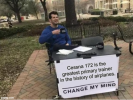I’ve got a buddy getting his CFI, that’s looking to buy an airplane to provide instruction, and he’s asking me for input. He’s a fellow Army helicopter driver, and he did have his FW PPL before he went to Army flight school. When it comes to singles, I don’t know what I don’t know. My first inclination is a tried and true 172, even though those prices are seemingly through the roof with all the flight schools lapping them up. But what model? As we know some years are to be avoided, with “gotcha” ADs and such.
Again, I don’t know what I don’t know. Or is a 172 even the way to go? Cherokee 160/180? I started my aviation career in the Army, so I skipped the GA single engine slog (don’t even have a PPL). My only SE time is a little over 50 hours in a Cherokee 180, and that was just to get my CSEL. Been flying my 310 ever since as far as GA is concerned.
He’s chomping at the bit to procure an aircraft and begin instructing. Any input would be appreciated. Thanks fellas.

